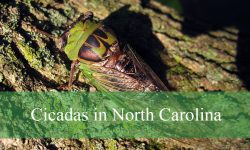Hummingbirds in Illinois span from the familiar Ruby-throated species to rare vagrants like the striking Magnificent Hummingbird. These tiny birds are admired for their vibrant colors, rapid wing beats, and remarkable hovering abilities.
During migration seasons, Illinois becomes a temporary home for several hummingbird species. Gardens, parks, and feeders provide essential nectar sources, attracting both familiar and rare species to birdwatchers’ delight.
Observing these hummingbirds offers insight into their behavior, feeding habits, and migration patterns. Each species has unique traits, making identification an exciting challenge for enthusiasts across the state.
Common Hummingbirds Found in Illinois
Ruby-throated Hummingbird (Archilochus colubris)
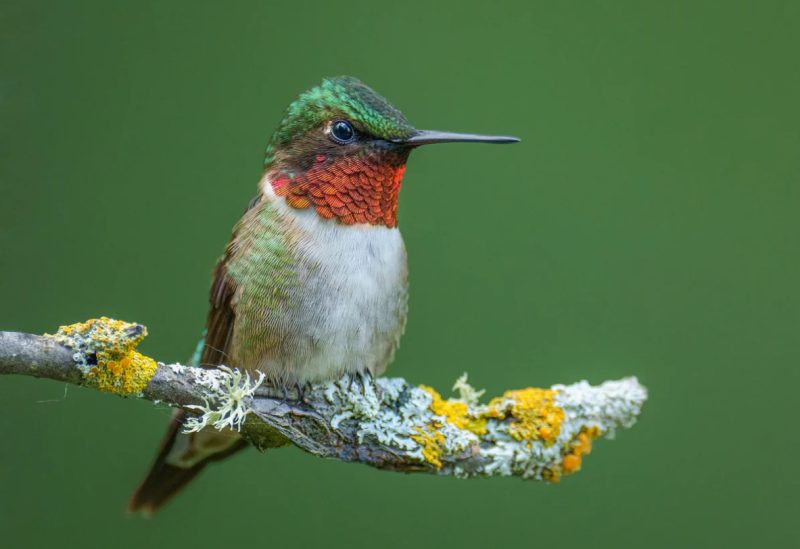
The Ruby-throated Hummingbird is the most common hummingbird in Illinois and the only regular breeder in the state. Adult males are easily recognized by their bright ruby-red throat, metallic green back, and grayish-white underparts. Females lack the red throat but display a green back and a white chest. These tiny birds measure about 3 to 3.5 inches in length with a wingspan of roughly 3.1 to 4.3 inches and weigh only 2 to 6 grams.
In Illinois, Ruby-throated Hummingbirds favor open woodlands, gardens, and areas with abundant flowering plants. They are highly territorial and are often seen aggressively defending nectar-rich feeders and flowers. These birds feed primarily on nectar but will also consume small insects and spiders for protein. Their rapid wing beats allow them to hover in mid-air, and they can fly forwards, backwards, and even upside down briefly.
During migration, these hummingbirds display remarkable endurance, flying non-stop across the Gulf of Mexico to reach Central America in winter. In Illinois, they are typically seen from late March to early October, with peak numbers in May and September. Nesting usually occurs in deciduous trees or shrubs, where females build delicate cup-shaped nests using plant fibers, spider silk, and lichens.
A fun fact about Ruby-throated Hummingbirds is that despite their tiny size, they can migrate over 500 miles across open water without stopping. Their heart rate can exceed 1,200 beats per minute during flight, and they are capable of entering a torpor—a hibernation-like state—at night to conserve energy.
Rufous Hummingbird (Selasphorus rufus)
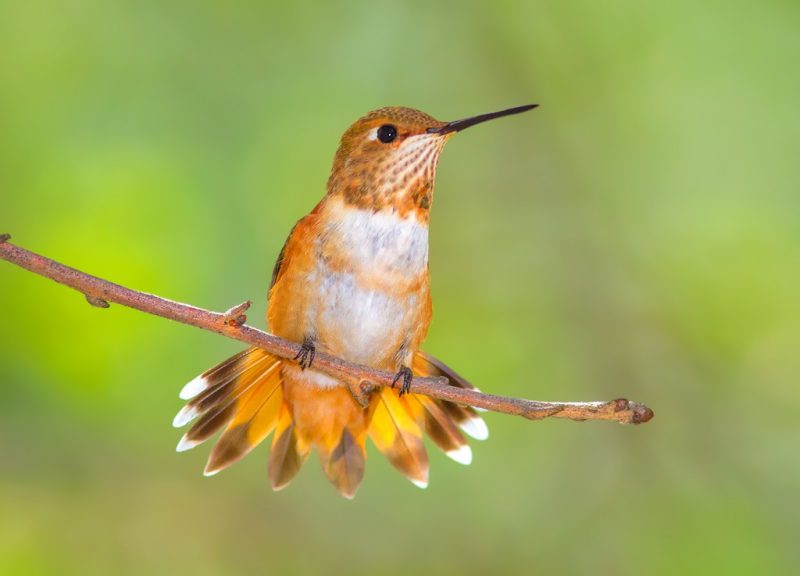
Rufous Hummingbirds are medium-sized hummingbirds that are more often seen in Illinois during migration rather than breeding. Adult males have a striking orange-red back and throat, with a white underbelly, while females and juveniles display green backs with rufous flanks. They measure about 3 to 3.5 inches in length, with a wingspan of 4 inches, and weigh around 3 to 4 grams. Their bold coloring and aggressive behavior make them noticeable at feeders.
These birds are highly territorial and will often chase away even larger hummingbirds to defend feeding areas. In Illinois, they are mostly spotted at backyard feeders and flowering gardens during spring and fall migration. Rufous Hummingbirds feed on nectar from tubular flowers and catch small insects for protein. Their flight is extremely fast and direct, with rapid wing beats that allow them to hover efficiently.
Rufous Hummingbirds migrate from their breeding grounds in the northwestern United States and western Canada to wintering areas in Mexico. Illinois serves as an occasional stopover, mostly in September and October. While they rarely nest in the state, these hummingbirds are attracted to areas with abundant nectar sources, especially in suburban gardens with feeders.
A fun fact about Rufous Hummingbirds is that they are considered one of the most aggressive hummingbird species. Despite being one of the smallest, they often dominate larger species at feeders. Their migratory journey is one of the longest for a bird of their size, covering thousands of miles from Alaska to Mexico.
Black-chinned Hummingbird (Archilochus alexandri)

The Black-chinned Hummingbird is a rare vagrant in Illinois, usually appearing during spring or fall migration. Adult males have a metallic green back, a black throat with a violet base, and a grayish-white underbelly. Females are green above with pale underparts and faint streaking on the throat. These hummingbirds measure about 3 inches in length, with a wingspan of roughly 4 inches, and weigh 2.5 to 4 grams.
In Illinois, Black-chinned Hummingbirds are most often found at feeders and gardens with abundant flowers during migration periods. They feed primarily on nectar but also catch small insects mid-air for protein. Like other hummingbirds, they exhibit rapid wing beats, remarkable hovering ability, and high agility in flight. Their territorial behavior is less pronounced than Rufous or Ruby-throated Hummingbirds but still notable.
Black-chinned Hummingbirds breed in the western United States and winter in Mexico. Sightings in Illinois are sporadic, making them a rare treat for birdwatchers. They are generally observed alone rather than in groups, often visiting feeders and flowering areas to refuel during long migratory flights.
A fun fact is that the Black-chinned Hummingbird is capable of entering torpor at night to conserve energy, allowing it to survive cooler temperatures during migration. Despite their rarity in Illinois, their brilliant metallic plumage often catches the eye of attentive observers.
Calliope Hummingbird (Selasphorus calliope)
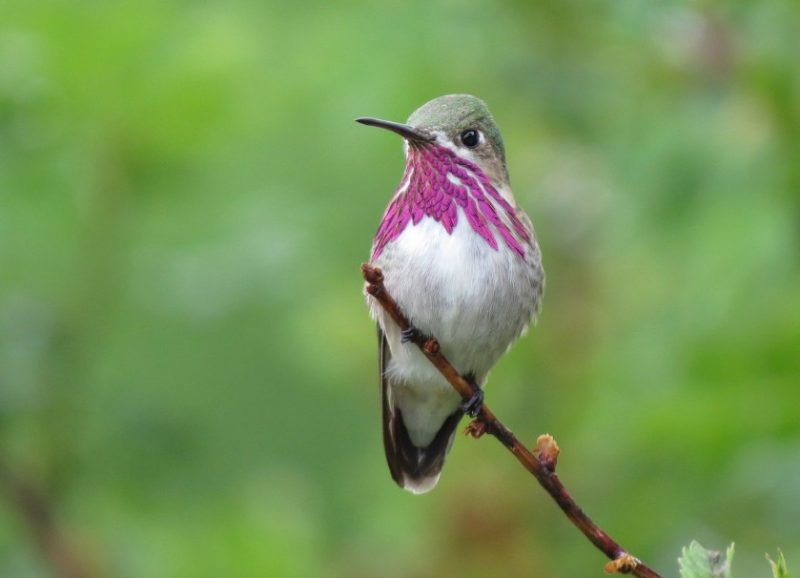
The Calliope Hummingbird, the smallest breeding bird in North America, is an uncommon migrant in Illinois. Adult males display a striking magenta throat that extends in streaks down the chest, with green backs and white underparts. Females and juveniles are more subdued, with green backs and faintly streaked throats. These tiny birds measure only 3 inches in length, have a wingspan of about 4 inches, and weigh just 2 to 3 grams.
Calliope Hummingbirds are highly energetic and feed primarily on nectar from small flowers, as well as tiny insects for protein. Their tiny size allows them to hover with incredible precision, and they are capable of rapid, darting movements to evade predators and rivals. Illinois sightings usually occur during late spring and early fall migration at feeders and flower gardens.
These hummingbirds breed in the northwestern United States and migrate to Mexico for winter. Illinois provides only a brief stopover for refueling, and their appearance is generally solitary. Birdwatchers prize these sightings because the Calliope’s size and vibrant throat make it distinctive among North American hummingbirds.
A fun fact about the Calliope Hummingbird is that it is the tiniest long-distance migratory bird in North America. Despite its minuscule size, it travels thousands of miles annually, showcasing extraordinary endurance for such a small species.
Broad-tailed Hummingbird (Selasphorus platycercus)
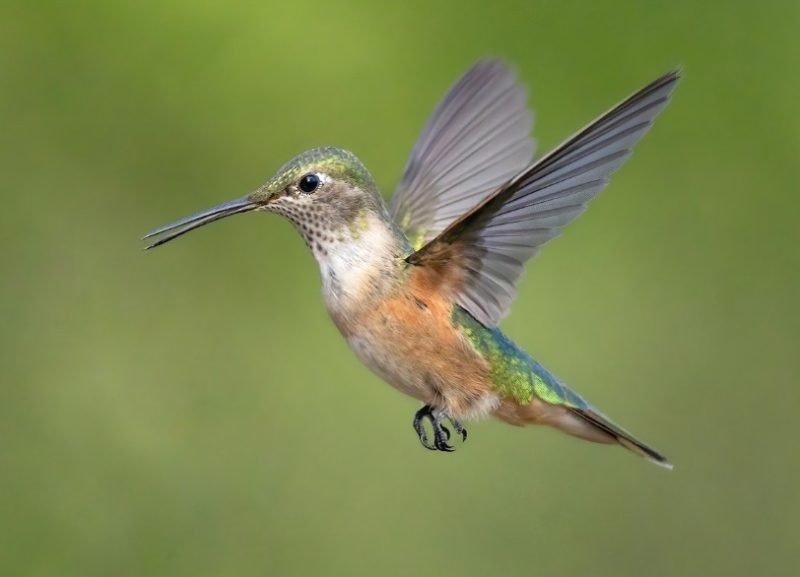
The Broad-tailed Hummingbird is a rare visitor to Illinois, usually appearing during fall migration. Adult males feature a striking iridescent rose-red throat, green back, and white underparts, while females are green above with pale throats and subtle streaking. These birds measure about 3 to 3.5 inches in length, have a wingspan of approximately 4 inches, and weigh 3 to 4 grams. Their tail is broad and slightly forked, which gives the species its name.
In Illinois, Broad-tailed Hummingbirds are typically found at feeders and flower gardens, especially during September. They feed primarily on nectar but also capture small insects for protein. Their flight is fast and direct, with rapid wing beats that allow precise hovering. Though less aggressive than Rufous Hummingbirds, they may still defend a rich feeding area from other hummingbirds.
Breeding usually occurs in the Rocky Mountains, and these birds migrate to Mexico for the winter. Illinois serves as a rare stopover point, and sightings are prized by local birdwatchers due to the species’ distinctive throat coloration and long migratory journey.
A fun fact is that male Broad-tailed Hummingbirds produce a high-pitched trill with their tail feathers during courtship displays. This unique sound, combined with their vibrant plumage, makes them particularly fascinating to observe.
Allen’s Hummingbird (Selasphorus sasin)
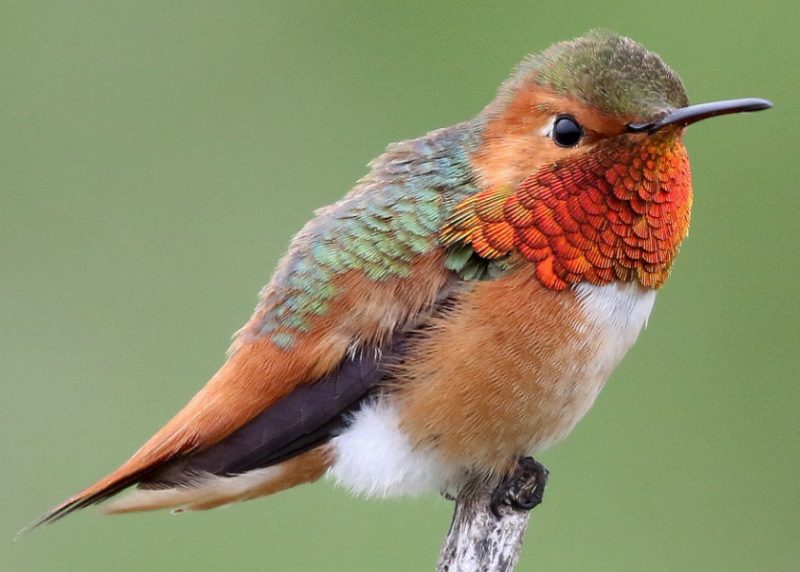
Allen’s Hummingbird is an extremely rare vagrant in Illinois, typically spotted during migration. Adult males have bright orange-red throats, green backs, and rufous flanks, while females and juveniles are green above with pale underparts and lightly streaked throats. They measure about 3 inches in length, with a wingspan around 4 inches, and weigh only 3 to 4 grams. Despite their small size, these birds are energetic and highly agile in flight.
In Illinois, Allen’s Hummingbirds are mostly seen at backyard feeders and gardens with nectar-rich flowers. They feed on nectar and small insects, hovering with remarkable precision and darting quickly between feeding sites. Territorial behavior is noted but not as aggressive as in Rufous Hummingbirds.
Allen’s Hummingbirds breed along the Pacific Coast and migrate to Mexico for winter. Their presence in Illinois is rare, making each sighting a notable event for local bird enthusiasts. They are generally solitary and cautious, often avoiding areas with high human activity.
A fun fact about Allen’s Hummingbird is that, like other hummingbirds, it can enter torpor at night to conserve energy, slowing its metabolism dramatically and reducing body temperature by up to half.
Broad-billed Hummingbird (Cynanthus latirostris)
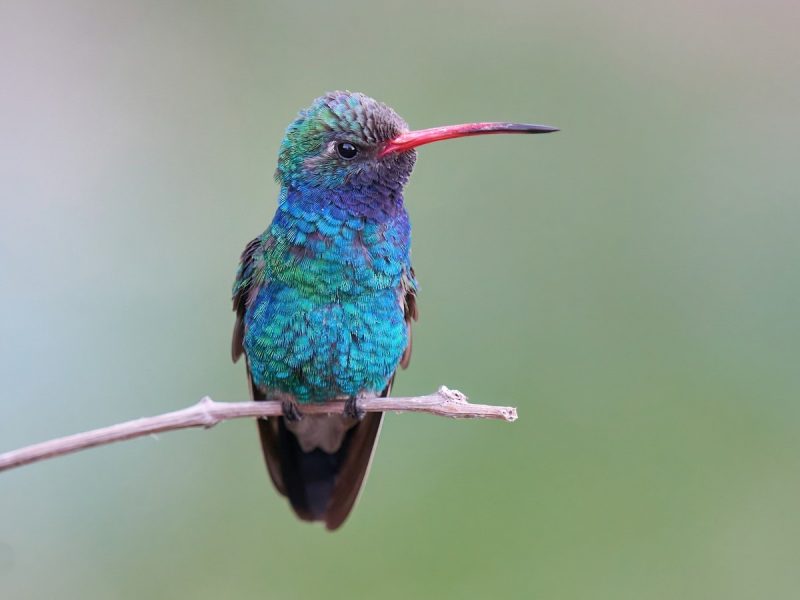
The Broad-billed Hummingbird is a vagrant in Illinois and is very rarely seen. Adult males are striking with bright blue throats, green backs, and vivid red bills with black tips. Females are duller, with green backs and pale throats, but they retain the characteristic red bill. They measure around 3 inches in length, have a wingspan of about 4 inches, and weigh approximately 3 grams.
In Illinois, sightings occur mostly at feeders during fall migration. They feed on nectar from tubular flowers and also catch small insects in flight. Broad-billed Hummingbirds are known for their rapid wing beats and hovering ability, allowing them to feed efficiently in tight spaces. They are generally solitary and territorial at feeders.
Breeding occurs in the southwestern United States and northern Mexico, with wintering areas further south in Mexico. Their appearance in Illinois is considered accidental, and birders get especially excited to spot this vividly colored species.
A fun fact is that the male Broad-billed Hummingbird performs aerial displays, producing a whirring sound with its tail feathers during courtship, a behavior similar to that of other Selasphorus hummingbirds.
Magnificent Hummingbird (Eugenes fulgens)
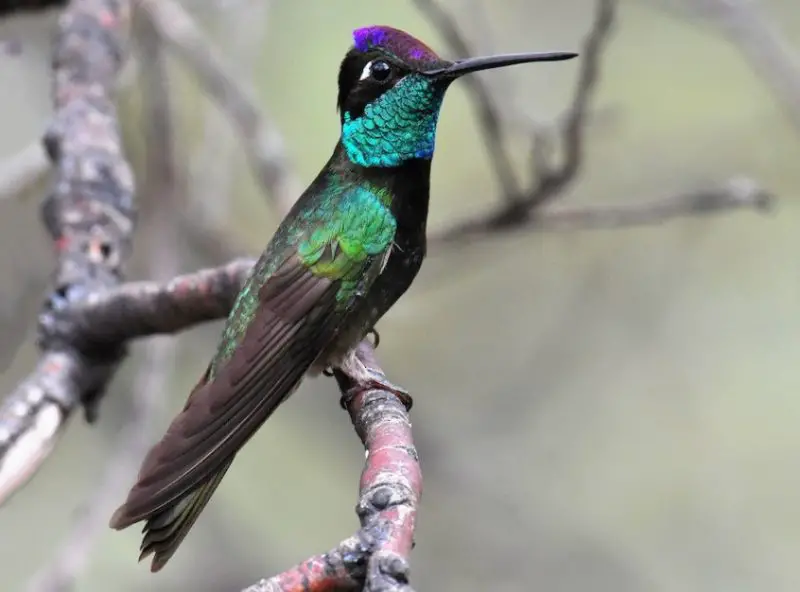
The Magnificent Hummingbird is an extremely rare vagrant in Illinois. Adult males boast iridescent emerald green backs, violet-blue throats, and long, broad tails with white tips, while females are green above with pale underparts and a short, dark tail. They are larger than most other Illinois hummingbirds, measuring 3.5 to 4 inches in length with a wingspan of 4.5 to 5 inches and weighing 4 to 5 grams.
In Illinois, sightings are very rare and usually limited to private feeders or gardens during migration. They feed primarily on nectar from tubular flowers and small insects, hovering gracefully while foraging. Their larger size and vivid plumage make them easily distinguishable from the more common Ruby-throated Hummingbirds.
Magnificent Hummingbirds breed in mountainous regions of Mexico and the southwestern United States, migrating to lower elevations in winter. Each Illinois sighting is considered noteworthy due to the species’ rarity and stunning coloration.
A fun fact about the Magnificent Hummingbird is that males often engage in dramatic courtship dives, flashing their vibrant throat feathers to attract females. Their striking colors and impressive flight skills make them a favorite among birdwatchers.
FAQs About Hummingbirds in Illinois
What is the most common hummingbird in Illinois?
The Ruby-throated Hummingbird is by far the most common species in Illinois. It breeds regularly in the state and is frequently seen at gardens and feeders from late March through October.
How many hummingbird species can be found in Illinois?
Illinois has 8 recorded hummingbird species, though most are rare vagrants. The full list includes Ruby-throated, Rufous, Black-chinned, Calliope, Broad-tailed, Allen’s, Broad-billed, and Magnificent Hummingbirds.
When is the best time to see hummingbirds in Illinois?
The best time is spring and fall migration, especially May and September, when Ruby-throated Hummingbirds are most abundant. Rare species usually appear during these migration periods as well.
Where are hummingbirds most likely to be spotted in Illinois?
Hummingbirds are commonly found in gardens, parks, and woodlands with abundant flowering plants. Backyard feeders with sugar water also attract both common and rare species.
What do Illinois hummingbirds eat?
Hummingbirds feed primarily on nectar from flowers and sugar water from feeders. They also consume small insects and spiders to meet their protein needs, especially during breeding season.
How can I attract more hummingbirds to my backyard in Illinois?
Plant native flowering plants such as bee balm, trumpet vine, and columbine. Providing clean hummingbird feeders filled with fresh sugar water and placing them in safe, sheltered areas increases your chances of attracting both common and rare species.
Are any hummingbirds in Illinois endangered?
Most Illinois hummingbirds, including the Ruby-throated Hummingbird, are not endangered. However, habitat loss and climate change can impact migration patterns and food availability, so conservation efforts are important.
Can I see rare hummingbirds like Rufous or Allen’s in Illinois?
Yes, but sightings are very rare. Rufous Hummingbirds appear occasionally during migration, while Allen’s, Broad-billed, Broad-tailed, and Magnificent Hummingbirds are extremely rare vagrants, mostly recorded at feeders or during birdwatching events.
Do hummingbirds stay in Illinois year-round?
No, most hummingbirds in Illinois, including the Ruby-throated Hummingbird, migrate south for the winter to Central America or the southern United States. Only occasional vagrants may appear outside of migration periods.
How do hummingbirds survive cold nights in Illinois?
Hummingbirds enter a state called torpor, which lowers their metabolism and body temperature, allowing them to conserve energy overnight. This is crucial for surviving cooler spring and fall nights.





